1. Introduction
In the era of the Fourth Industrial Revolution, companies are actively involved in digital transformation as an innovative strategy to secure competitiveness and achieve growth. The International Data Corporation (IDC) defines digital transformation as a continuous process of adapting to or driving disruptive changes in customers and markets (the external ecosystem) by using digital capabilities to create new business models, products, and services. AT Kearney defines digital transformation as an enterprise activity that proactively responds to changes in the business environment triggered by digital technologies such as mobile, cloud, big data, artificial intelligence (AI), and IoT(Internet of Things), aiming to significantly enhance the competitiveness of existing businesses or pursue new growth through innovation. According to IBM, it is a strategy that involves the integration of digital and physical elements to transform business models and establish new directions within industries.
One significant aspect of digital transformation is the increasing importance of collaboration networks within companies and among various partners within the value chain. Digital transformation enables the establishment of organic collaboration networks among raw material suppliers, component providers, service providers, and research institutions within the value chain, facilitating seamless data exchange. The integration of comprehensive and organic production processes through networking among companies in the value chain can lead to improved productivity through supply chain synchronization, efficient resource utilization, reduced production lead times, and accelerated innovation cycles (
Oh and Kim, 2022).
The shipbuilding and marine engineering industry, particularly Engineering to Order (ETO) industries, is a representative example where various tasks such as design, material procurement, sourcing, and production are performed simultaneously once an order is received from a client The processes in this industry are complex and have different levels of difficulty, with multiple companies collaborating cooperatively at each stage of the process.
Therefore, the Korean shipbuilding and marine engineering industry, primarily led by large corporations, is vigorously promoting digital transformation as a core strategy to enhance productivity, reduce costs, and focus on core business activities. Many digital transformation initiatives are planned and executed in the areas of Smart Factory/Yard and Smart Ship, with a primary focus on large corporations, aiming to enhance the competitiveness of the shipbuilding and marine engineering industry. However, for more than 50% of partner companies, including suppliers, in the shipbuilding and marine engineering value chain, the implementation of digital transformation strategies is challenging because of the complexity of internal operations and a lack of digital transformation experts. This implies that the technological interfaces related to digital transformation initiatives pursued by large corporations are not sufficiently established, limiting the effectiveness of digital transformation initiatives within large corporations and, consequently, the overall impact of digital transformation across the shipbuilding and marine engineering value chain.
In this study, we analyzed the overall progress of digital transformation and reviewed digital transformation cases from the perspective of cooperation between large, medium, and small-sized enterprises to propose a master plan for cooperative digital transformation for the Korean shipbuilding and marine engineering industry. This plan is expected to foster consensus on collaborative value chain development based on digital transformation in the shipbuilding and marine engineering industry. To this end, we analyzed the current collaboration status between large corporations and partner companies and explored methods to establish an efficient and structured collaborative ecosystem by leveraging digital transformation technologies. Moreover, to facilitate this endeavor, we planned and executed strategies to secure momentum within related internal and external organizations, focusing on a large shipbuilding company ŌĆ£HO CompanyŌĆØ (formerly known as ŌĆ£D CompanyŌĆØ). Specifically, the responsibilities of the shipbuilding company include providing support for enhancing competitiveness, such as procurement and outsourced production, improving its collaboration systems, and sharing data with partner companies. Partner companies are tasked with enhancing competitiveness by establishing and advancing digital transformation-based systems, such as suitable smart factory systems. These efforts enable the exchange of production and manufacturing information between the shipbuilding company and partner companies using digital transformation technologies. Moreover, to activate the ecosystem within the shipbuilding and marine engineering sector, government agencies should increase financial support by allocating budgets for the development of smart factory systems based on digital transformation, an area where the direct intervention of shipbuilders is restricted to maintaining fairness. Furthermore, by fostering specialized information and communications technology (ICT) companies with in-depth knowledge of the shipbuilding and marine engineering sector and expertise in digital transformation technologies, they will provide technical interface support for digital transformation and develop solutions to bridge the technological gap between large corporations and partner companies. This approach is expected to enhance the overall competitiveness of the entire South Korean shipbuilding and marine engineering value chain using digital transformation.
2. Preliminary Research on Digital Transformation
2.1 Analysis of the Digital Transformation Concept
With the widespread adoption of the government-led Fourth Industrial Revolution, several companies are embracing digital transformation. Previous studies have primarily focused on defining the concept and meaning of digital transformation based on the prevailing trends at the time.
Martin (2008) defined digital transformation from the perspective of ŌĆÖthe use of digital technology by individuals. Specifically, it refers to the ultimate stage of digital literacy, which includes the technical ability to effectively utilize digital tools and perceptual skills to determine when to use them. Furthermore, it enables innovation and creativity in advanced levels of digital usage. However, as the adoption of digital technology is an organizational decision, digital transformation is generally considered an organizational concept rather than an individual concept.
White (2012) defined digital transformation as a concept that emerges when individuals, organizations, and societies adopt new digital technologies. It also encompasses changes in business models resulting from the use of digital technology.
Kreutzer (2014) defined digital transformation as the process of changing customersŌĆÖ interaction with the market in response to the rapidly changing market conditions and business models. The author emphasized that adapting to such changes is essential for survival in a competitive environment.
Westerman et al. (2014) stated that digital transformation includes the use of technology to expand the scope of a companyŌĆÖs business. It also involves changes within the corporate culture and processes of an organization as a result of the broader societal and individual changes caused by the adoption of digital technology. From a strategic business perspective, digital transformation also encompasses changes in business models.
According to
Schwab (2017), digital transformation involves adopting Fourth Industrial Revolution digital technologies into a companyŌĆÖs business model. It has four major effects including meeting customer expectations, improving products, promoting collaborative innovation, and transforming organizational structures. Schwab emphasized that in an era where customers are increasingly central to the economy, enhancing customer service has become the primary goal for companies, and digital capabilities can enhance both physical products and services.
Morakanyane et al. (2017) argued that the literature between 2011 and 2016 lacks consensus regarding the definition of digital transformation. Moreover, they provided a conceptual framework for digital transformation by analyzing the characteristics of commonly used terms.
Udovita (2020) described the process of digitalization using the terms, ŌĆ£digitizationŌĆØ and ŌĆ£digitalization.ŌĆØ. The former refers to the conversion of analog technology, information, and products into digital formats, and the latter refers to creating new revenue and socio-economic value through changes in business models or processes using digital opportunities.
Digital transformation is defined as a restructuring that arises from changes in individuals and society resulting from digitalization. A thorough review of the literature reveals that digital transformation emphasizes changes and innovations resulting from the evolving trends in digital technology, particularly in the realms of business and IT. To optimize the advantages of digital transformation, concepts and definitions that have attracted global attention since 2010 should be investigated and implemented.
Essentially, digital transformation optimizes IT infrastructure, enhances customer-centric business models, increases service value, and promotes external collaboration using innovative digital technologies. Such changes encompass personal, organizational, and societal transformations in the pursuit of efficient internal operations.
According to
Vial (2019), digital transformation is a more advanced concept than IT-based transformation and requires continuous evolution through the active use of emerging technologies. Digital transformation has significant implications for organizations as they adapt to changes in the business environment, consumer behavior, and internal innovation. With the increasing demand for mobile devices among consumers, companies can enhance customer experiences by developing mobile applications that strengthen customer communication, data collection, and analysis. Adaptation to these real-time changes can be considered as a form of digital transformation (
Lee et al., 2022).
Bonnet et al. (2020) emphasized the importance of becoming digital masters for companies to drive digital innovation. A digital master refers to an individual who possesses both digital and leadership capabilities, enabling organizations to improve business elements and drive change. In recent years, the development of advanced technologies such as IoT and AI has made digital innovation increasingly complex. Therefore, although leadership skills are crucial, digital capabilities are emerging as a new essential element.
2.2 Research on Digital Transformation in German SMEs
Studies on German Small and Medium-sized Enterprises (SMEs) have reported that approximately 80% of the surveyed companies identified optimizing production processes through inter-company networking as a primary goal. Leveraging digital transformation ensures the sharing and utilization of production process data between companies, enabling swift identification and improvement of weaknesses in the value chain. Furthermore, the enhancement of production and services has emerged as a core value for digital transformation. Notably, digital transformation can lead to the optimization of existing production processes while fostering the development of new products and services. However, networking-associated costs are an obstacle to its promotion, with companies displaying a lack of trust in the expected benefits of high-cost networking.
Furthermore, digital transformation initiatives emphasize the growing significance of data security through enhanced inter-company networking within and beyond the value chain. According to
Oh and Kim (2022), during the planning and pilot phases of digital transformation, factors such as a shortage of relevant personnel, inadequate legislation, and internal resistance posed significant challenges for companies. Nevertheless, cybersecurity has emerged as a critical concern in subsequent stages of application and digital transformation. Therefore, the presence and maturity of industries that can provide security solutions are crucial for effective digital transformation.
2.3 Research on the Digital Transformation Process in Mid-sized Manufacturing Companies
Digital transformation comprises the use of digital technology to enhance operations, improve productivity, create innovative business models, and enhance customer experiences as a strategic management approach. According to the IDC, 89% of companies consider digital transformation a crucial managerial priority, with an expected market growth rate of 23% by 2025. This underscores the importance of digital transformation as a response to competition and a means to achieve business success and sustainability. However, McKinsey reported that 70% of digital innovation initiatives fail because of various factors such as resistance to change, inadequate leadership, poorly designed processes, lack of inter-departmental collaboration, and a shortage of digital skills. One of the core elements highlighted by the Boston Consulting Group is the importance of ŌĆ£peopleŌĆØ in achieving effective digital transformation, emphasizing a member-centric perspective and the integration of data and processes. Digital transformation is not a static change but a dynamic process requiring internal and external transformations. IDC predicted that by 2022, 65% of the global GDP will be digitized, with approximately $2 trillion invested in technology and services in this domain.
Digital transformation is a long-term and continuous process that requires well-defined objectives, efficient resource allocation, and a specific execution plan for effective implementation. Hence, active support and leadership from the management team are essential to drive digital transformation. This strategy encompasses a wide range of tasks, including improving operational efficiency through the use of digital technology, strengthening operations, renewing customer experiences, and developing new business. For effective digital transformation, CEOs need to possess technological expertise, prioritize digital trends, and drive innovation. Therefore, exceptional technological insight and drive from the leadership team are necessary, and the success of digital transformation hinges on a company-wide strategy and systematic implementation. Digital transformation has been considered a strategic concept since the late 2000s for enhancing value across various business functions, from production to services, by addressing vulnerabilities in the value chain based on the analysis results of existing studies (
Kim, 2022).
3. Status of ICT-Based Collaboration in Medium and Small-Sized Enterprises
Since 2008, South Korean shipbuilding companies have been developing and maintaining collaboration systems to share information related to procurement and external production with their partner companies. Furthermore, they have supported their partners in establishing smart factories through government-funded projects.
Fig. 1 shows the collaboration system development and support for HO Company, a prominent shipbuilding company in South Korea, highlighting the gradual progression of system development for collaboration support among major shipbuilding companies.
To facilitate seamless collaboration between shipbuilders and their partner companies, information regarding drawings, materials, schedules, transportation, and regular updates on the progress of mutual processes is shared. For partner companies without their systems, shipbuilders utilize Excel-based data for sharing collaboration information. However, partners with their systems are required to separately access and register collaboration data.
Fig. 2 shows the service framework for establishing collaboration between shipbuilders and partner companies. Information sharing within the shipbuilding industry is primarily based on Excel, with plans and execution information shared between parent companies and partner companies. Some partner companies equipped with enterprise resource planning/manufacturing execution system (ERP/MES) consider collaboration from a system perspective.
In the shipbuilding industry, information sharing between shipbuilders and SMBs is predominantly important. But it is difficult to standardize ICT systems between shipbuilders and partner companies. So Excel-based information sharing is mostly done owing to the characteristics of the industry.
Consequently, partner companies cannot easily adopt ICT-based systems. As presented in
Table 1, which provides an overview of the current state of partner companies in the shipbuilding and maritime industry by region and function, the possession rate of information systems such as ERP/MES among partner companies in the Gyeongsangnam-do and Busan regions is low at 31%. The absence of these information systems poses constraints on smooth collaboration and information exchange, ultimately impacting the competitiveness of large shipbuilders at the top of the value chain. To address this issue, shipbuilders and partner companies need to collaborate to establish efficient and effective ICT systems for symbiotic collaboration.
Therefore, shipbuilders and partner companies manage symbiotic collaboration using collaboration systems provided by shipbuilders, along with Excel-based tools, as shown in
Fig. 3. However, the absence of their information systems poses significant limitations in achieving smooth collaboration and information exchange.
Similarly, the majority of partner companies in the shipbuilding and maritime industry significantly rely on Excel for business management. Even when developing systems, efficient implementation can be challenging, potentially resulting in reduced utility because of a lack of skilled personnel and significant manual work related to tasks and operations. Nonetheless, high-quality information systems are crucial as they serve as the foundation for digital transformation.
Furthermore, to address limitations related to source data sharing due to national infrastructure constraints, advanced security systems should be implemented, along with support for enhancing the ease of source data sharing through information systems for design and production information.
Table 2 presents an overview of the characteristics of the field of each business partner, emphasizing areas that require significant manual work and information management.
4. Fundamental Plan for Digital Transformation-based Collaborative Cooperation
A strategic approach emphasizes developing a standardized open digital foundation system to support process innovation for various partners, instead of crafting a system exclusively for a specific partner. Notably, field experts should be involved when conducting practical process innovatory consultation. Additionally, shipbuilding companies must establish 3D model-based design/production information delivery systems to expand ongoing digital transformations to external production. Then, partner companies can leverage this system and information to minimize vulnerabilities in the shipbuilding and maritime industries, enhance productivity, and reduce costs. Shipbuilding and partner companies should build a technology interface system and automate all processes except those requiring personnel.
Fig. 4 shows the direction for establishing a collaborative system for digital transformation. This system should be constructed on a platform that enables data exchange between shipbuilding and partner companies through a common format, rather than integrating data separately for each shipbuilder and its partners. For partner companies without ICT expertise, cloud-based system services should be provided. Notably, the leadership of this system should be implemented in coordination with government-supported projects, rather than being solely initiated by a specific shipbuilder.
The framework presented in
Fig. 5 summarizes the necessary tasks for promoting collaborative cooperation, including the development of a digital transformation-based collaboration platform, the development of a common data exchange platform between shipbuilders and partner companies, and digital transformation consulting, based on digital transformation. These efforts should be based on the smart factory standard model integrated with the collaborative systems in shipbuilding companies.
The priority for advancing tasks related to collaborative cooperation based on digital transformation is shown in
Fig. 6, considering both urgency and feasibility. Depending on the tasks, government agencies and shipbuilding companies should take the lead in their implementation. Furthermore, specific tasks and roadmaps for digital transformation-based collaborative cooperation have been established based on business items and priorities, as shown in
Fig. 7. This roadmap was developed through extensive consultations with experts related to HO Company over several months.
The key tasks and priorities for promoting collaborative cooperation based on digital transformation in the shipbuilding and marine engineering industries are as follows:
(1) Enhancing shipbuilding company collaboration systems: Improve systems to enable smooth information exchange with partner smart factory systems.
(2) Establishing collaborative cooperation models: Develop a digital transformation-based smart factory construction consulting system, establish a smart factory standard model, enhance the digital collaborative cooperation platform, and create a shared data exchange platform.
(3) Implementation and deployment of smart factory systems by partner companies: Promote the implementation of smart factory systems in partner company fields.
(4) Promotion of Government-Agency-Led Cooperative Projects: Promote support for smart factory construction, pursue agreements on digital transformation-based collaborative cooperation master plans, and provide consulting support to partner companies.
These tasks should be prioritized based on urgency and ease of implementation and can be performed through collaboration between government agencies and shipbuilding companies/partner companies.
5. Conclusion
Digital transformation is a global phenomenon and is widely recognized as a crucial strategy. In South Korea, both the government and businesses are actively promoting digital transformation to enhance competitiveness across various industries. Major shipbuilding companies in the maritime industry have already embarked on their digital transformation journey, achieving remarkable results through various applications in both smart yards and vessels since 2019. The smart yard system shown in
Fig. 8 enables digital management of production based on a digital twin, and the development of autonomous navigation smart vessel systems shown in
Fig. 9 effectively showcases the outcomes of these efforts. Given the high dependence of the shipbuilding and maritime industry on partnerships, the digital transformation of partner companies is expected to strengthen the value chain of South KoreaŌĆÖs maritime industry. Therefore, major shipbuilding companies and government agencies should collaborate and support the advancement of digital transformation.
In this study, we provided a broad overview of the content of technology interfaces between partner and shipbuilding companies based on digital transformation. The findings of this research are currently under consideration for potential government projects, in consultation with government agencies such as Gyeongnam Techno Park (TP), Busan TP, and the Research Institute of Medium & Small Shipbuilding. The significance of this study lies in its insights into the digital transformation-based collaborative cooperation in the complex collaborative structure of the shipbuilding and maritime industry. The research results can serve as a reference model for digital transformation-based collaborative cooperation in other ETO industries. Future research will focus on the establishment of an information exchange platform, a fundamental component of digital transformation-based collaborative cooperation systems.
Conflict of Interest
Young-Hun Kim serves a journal publication committee member of the Journal of Ocean Engineering and Technology, but he had no role in the decision to publish this article. No potential conflict of interest relevant to this article was reported.
Funding
This research was funded and conducted under the Competency Development Program for Industry Specialists of the Korean Ministry of Trade, Industry and Energy (MOTIE), operated by Korean Institute for Advancement of Technology (KIAT) (No. P0012646, HRD program for Global Advanced Engineer Education Program for Future Ocean Structures).
Fig.┬Ā1.
Implementation of collaboration ICT system
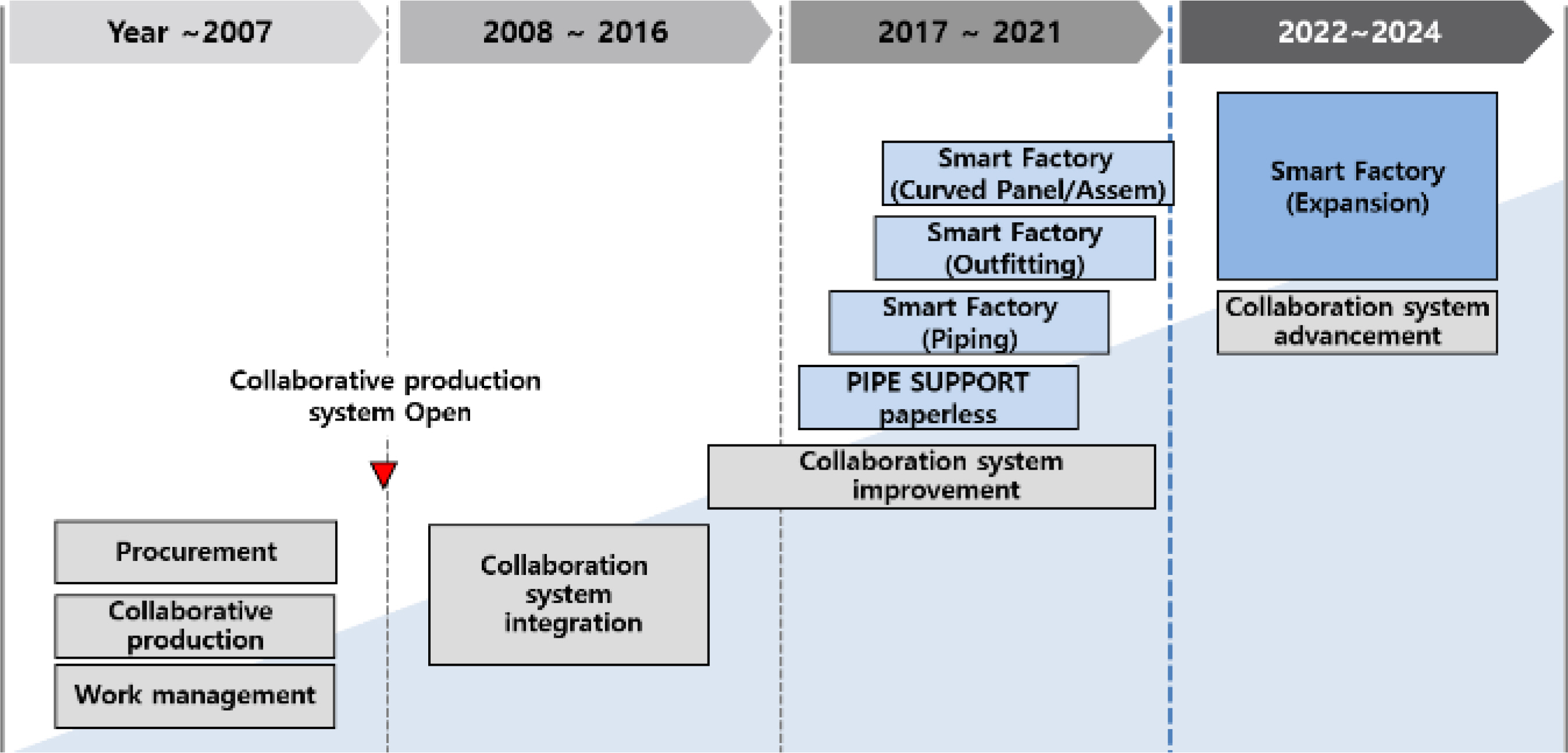
Fig.┬Ā2.
Collaboration service in the shipbuilding and marine Biz.
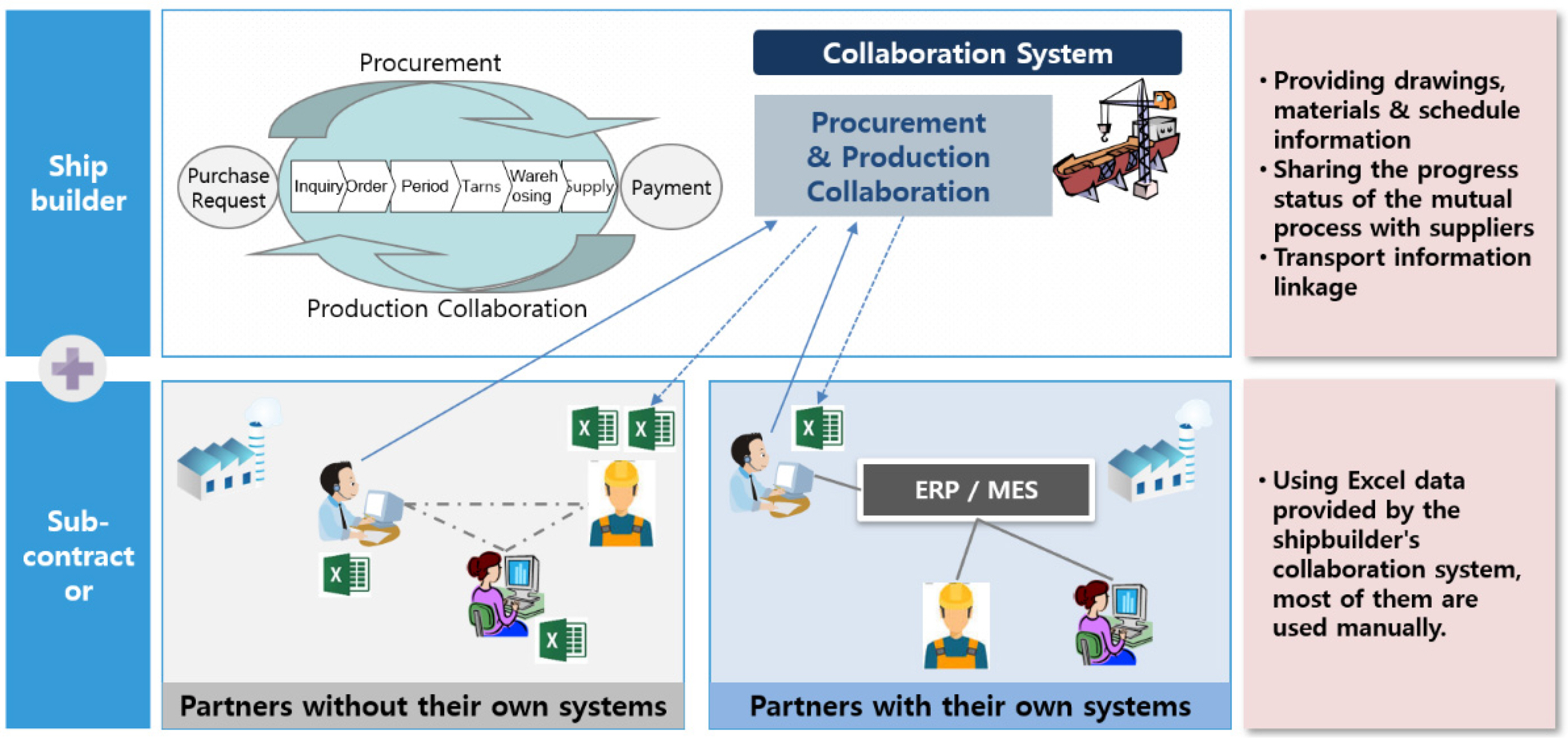
Fig.┬Ā3.
Current status of cooperation between companies

Fig.┬Ā4.
Partner collaboration system implementation architecture
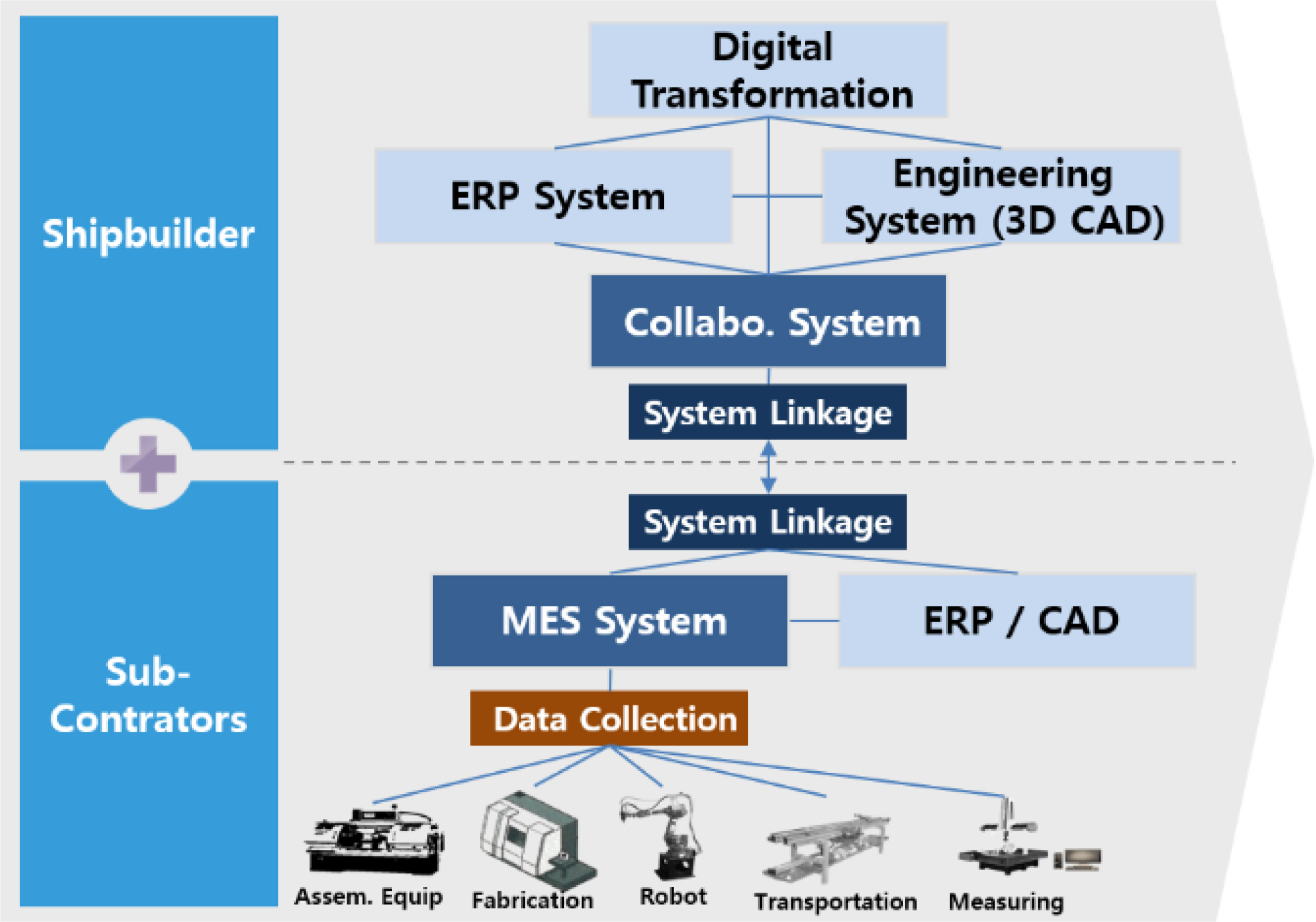
Fig.┬Ā5.

Fig.┬Ā6.

Fig.┬Ā7.
Road map for digital transformation-based collaboration
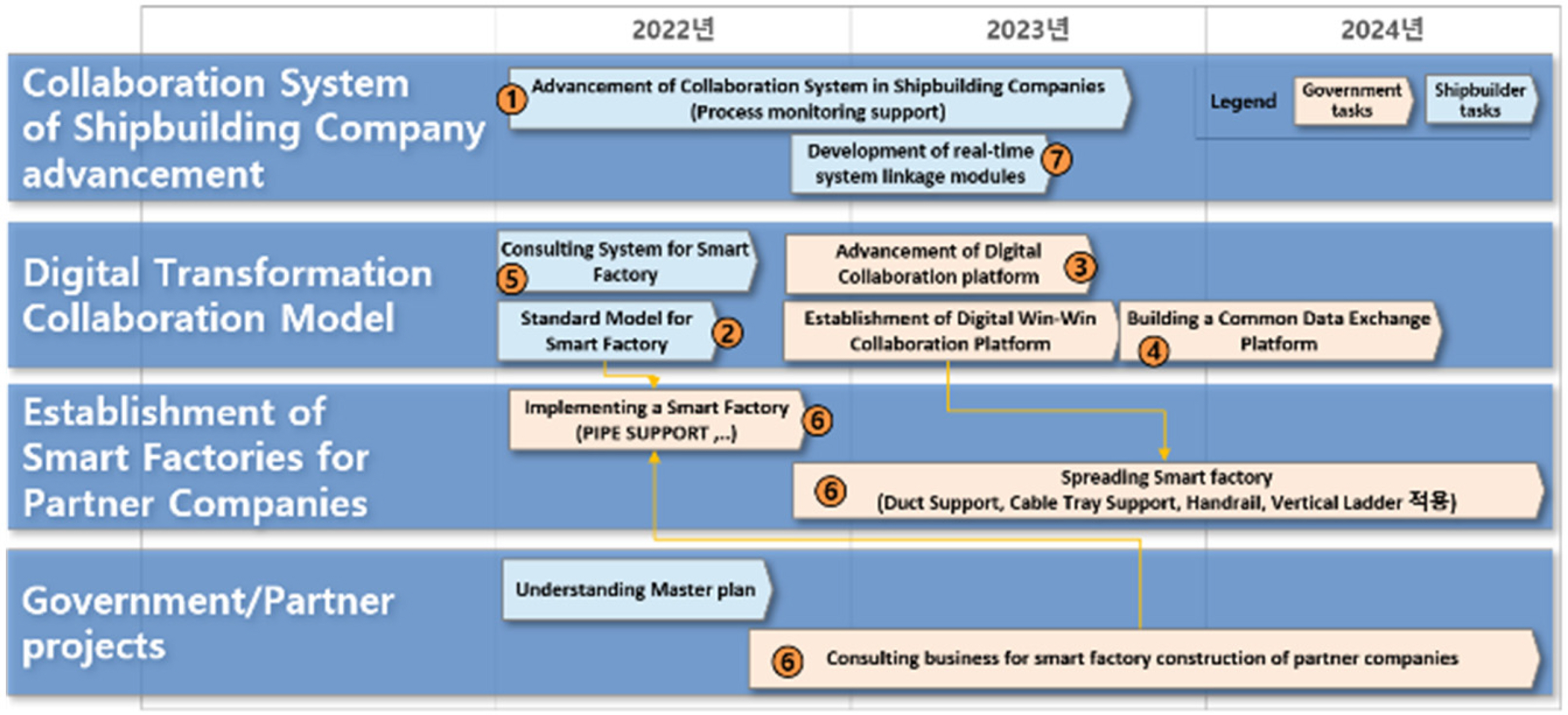
Fig.┬Ā8.
Case of smart yard development (Digital twin-based digital production center system)
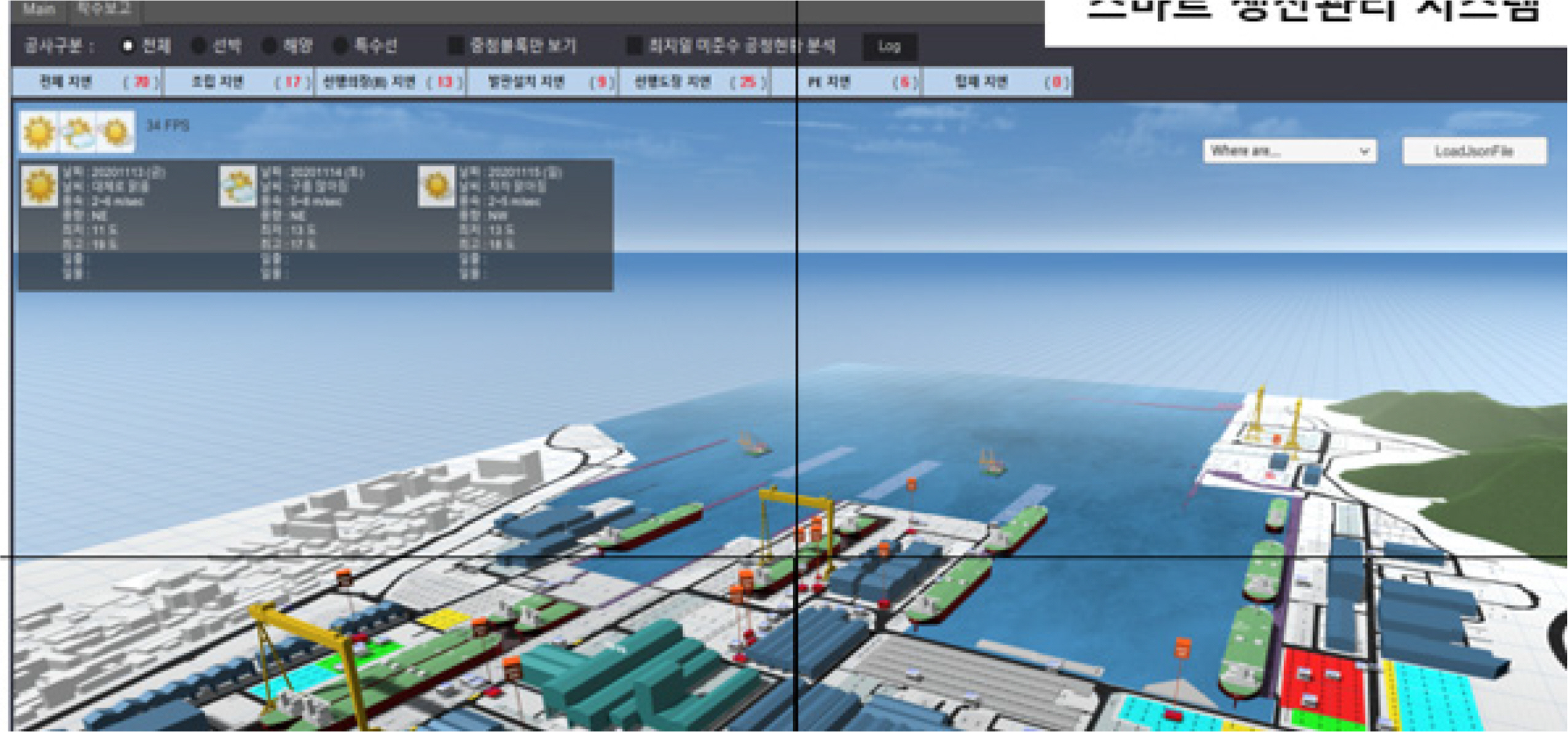
Fig.┬Ā9.
Case of smart vessel development (Autonomous vessel navigation system)
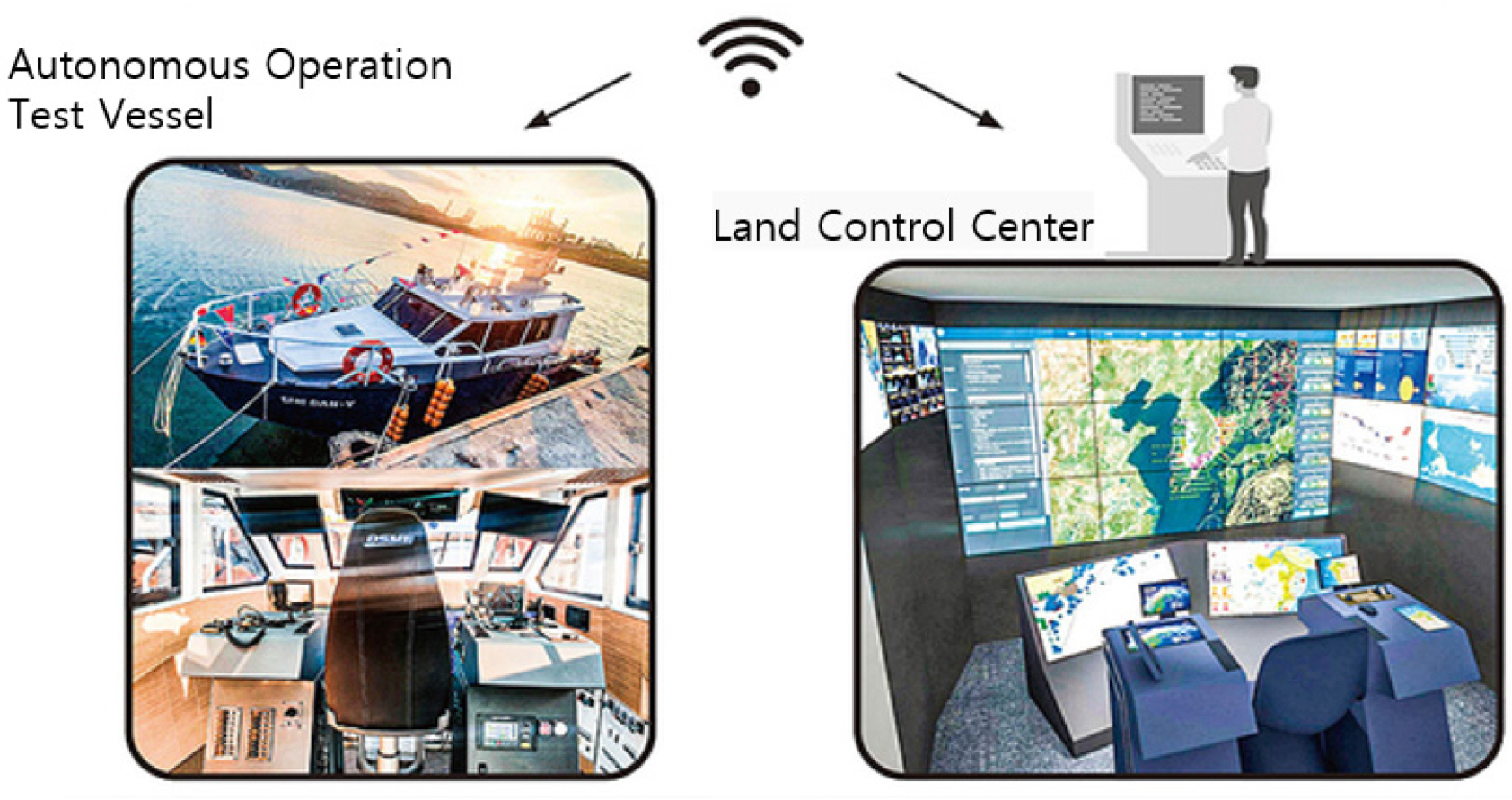
Table┬Ā1.
Shipbuilding partners by region/field & ICT status
|
Current status of subcontractorŌĆÖs number |
|
|
City |
Hull |
Machi. |
OutfitŌĆÖg |
Elec. |
sum |
|
|
Busan |
19 |
36 |
260 |
54 |
398 |
|
Gyeongsangnam-do |
22 |
32 |
357 |
29 |
440 |
|
Ulsan |
11 |
18 |
86 |
17 |
39 |
|
Junnam |
20 |
2 |
81 |
1 |
104 |
|
Others |
7 |
13 |
110 |
64 |
258 |
|
|
SUM |
79 |
101 |
894 |
165 |
1,239 |
|
|
Current status of subcontractorŌĆÖs number |
|
|
Region |
Sum (company) |
ICT sys. |
manual |
Rate of Holding ICT sys. |
|
|
Gyeongsangnam-do & Busan |
185 |
58 |
127 |
31% |
Table┬Ā2.
Business specifications of partner companies
|
Kind |
Job Issues |
|
Pipe |
Many manual tasks are required to generate individual PIECE drawing files and connect them to PIECE information by receiving production POR drawings from the customer and SCAN of the drawings |
|
Valve |
Standard BOM is managed because of the numerous mass products of various varieties, and the appropriate inventory of STOCK items must be maintained and managed because of numerous emergency orders. |
|
Equipment |
Owing to the production of order-based products, BOM is often reorganized except for standard products. Therefore production BOM management is required |
|
Steel Out. |
Many work instructions and purchase orders are provided because of numerous tasks in the form of in-house outsourcing, inventory management, storage location, and material warehousing of manufactured products |
References
Martin, A. (2008). Digital literacy and the ŌĆ£digital societyŌĆØ. In: Lankshear C, Knobel M, eds. Digital literacies: Concepts, policies and practices. 30: p 151-176. Peter Lang..
White, M. (2012). Digital workplaces: Vision and reality.
Business information review,
29(4), 205-214.


Kreutzer, R. T. (2014). Digital Darwinism and the need for a digital transformation.
International Conference on Business Strategy and Organizational Behaviour (BizStrategy). Proceedings. p 38 Global Science and Technology Forum.

Westerman, G., Bonnet, D., & McAfee, A. (2014). The nine elements of digital transformation. MIT Sloan Management Review, 55(3), 1-6.
Morakanyane, R., Grace, A. A., & OŌĆÖreilly, P. (2017). Conceptualizing digital transformation in business organizations: A systematic review of literature.
BLED 2017 Proceedings. 21.
https://aisel.aisnet.org/bled2017/21

Schwab, K. (2017). The fourth industrial revolution. Crown Business.
Oh, J. T., & Kim, E. H. (2022). ĻĖ░ņŚģņØś ļööņ¦ĆĒäĖ ņĀäĒÖś Ļ▓Įņ¤üņÜ░ņ£ä ņÜöņåīņŚÉ Ļ┤ĆĒĢ£ Ļ│Āņ░░: ĒżĒä░ņØś ļŗżņØ┤ņĢäļ¬¼ļō£ ļ¬©ļŹĖņØä ĻĖ░ļ░śņ£╝ļĪ£ [A study on the competitive factors of digital transformation in enterprises: Based on PoterŌĆÖs diamond model]. Korean Management Consulting Review, 22(3), 207-224.
Lee, S. J., Choi, Y., Ra, J., & Kho, H. S. (2022). An exploratory study on digital transformation services.
Journal of Information Technology and Architecture,
19(2), 73-91.
https://doi.org/10.22865/jita.2022.19.2.73


















